If you want to experience rural England at its quintessential best, you will struggle to do better than the Peak District.
Quaint villages, rolling hills, swooping valleys, stately homes and castles; the timeless beauty of England’s oldest National Park is always a joy to behold.
From sleepy villages to slightly-busier towns; I’ll guide you through the Peak District’s best places to stay.
Disclaimer: Hi! this post may contain affiliate links which will take you to online retailers that sell products and services. If you click on one and buy something, I may earn a commission, see my Affiliate Disclosure for more details.
Bakewell
Best For: Location, Charm and Puddings

Settled on the River Wye, this little storybook town – of Bakewell Pudding fame – is one of the most visited places in the whole of the Peak District.
Bakewell has carved out its place as the heart of the Peak District, encapsulating everything we love most about the beloved National Park. It’s quaint with lovely architecture, filled with stone cottages and pretty ancient fixtures like Bakewell Bridge.
The town is blessed with plenty of character and rural charm, with a collection of small boutiques and independent stores to browse. It also has a long history and is surrounded by outstanding natural beauty.
Most importantly, it has Bakewell Pudding.
You can’t stay in Bakewell and not try a Bakewell Pudding. It has long been a point of local contention agreeing on the exact location of its origin. But the general consensus seems to be that The Old Original Bakewell Pudding Shop is the place to go. They have a cosy restaurant serving the puddings – and other, less important things – upstairs.
If you don’t have time to stop, you can grab a pudding (or its more famous cousin, the Bakewell Tart), to take away from the bakery on the ground floor.
Bakewell is also close to Chatsworth House and the 11th Century Haddon Hall, both of which are worth visiting.
The Monsal Trail, which involves following an abandoned Victorian Railway, isn’t far away. It’s one of my favourite walks in the Peak District.
Buxton
Best For: People Without A Car
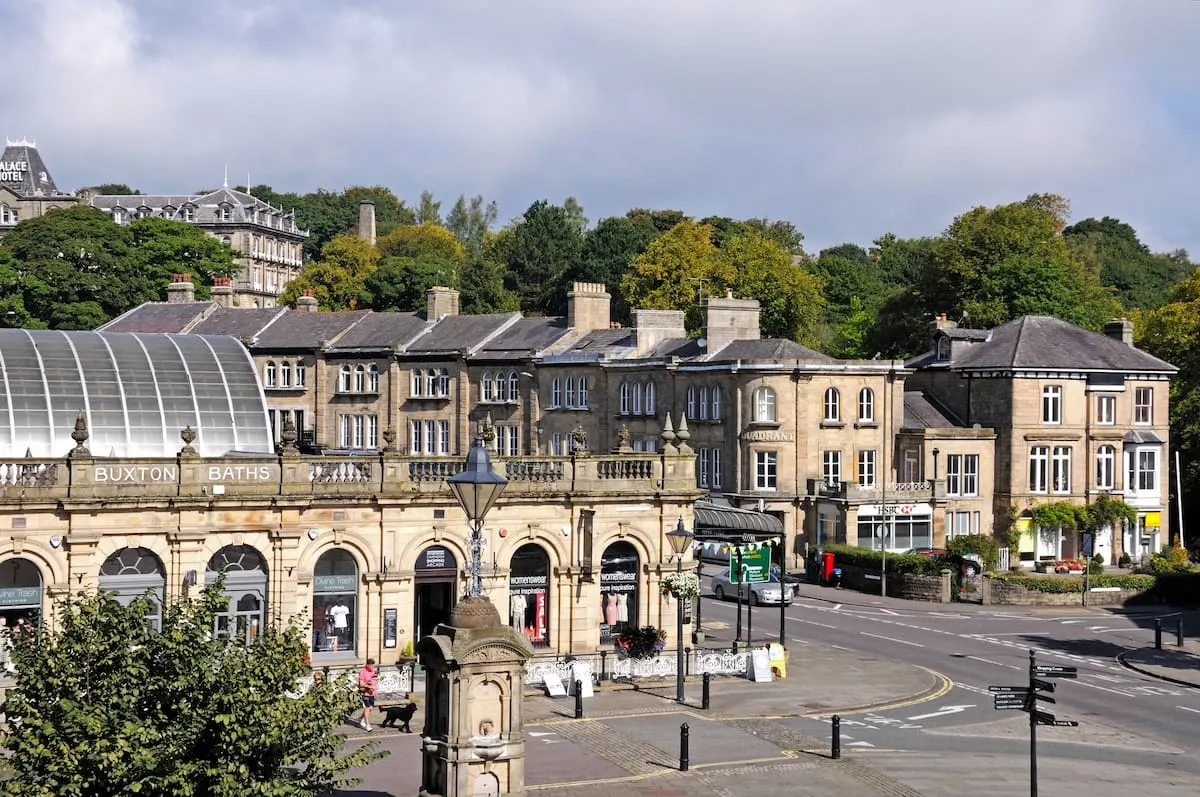
Buxton isn’t technically in the Peak District as it occupies its own little island of space between the borders. It’s an honorary member though – it’s so close and similar to other parts of the Peak District that it might as well be one.
Though the Peak District doesn’t lend itself well to people without a car, Buxton, and perhaps Bakewell, are your best options.
You can reach Buxton by train from the likes of Manchester, and use the bus network from there. Though buses aren’t the most frequent in rural areas, they link between Buxton, Bakewell and Castleton fairly regularly.
The Pavilion Gardens are my favourite part of Buxton. It’s really lovely just to walk around them and admire the workmanship involved.
From an architectural standpoint, Buxton is one of the most interesting towns in Derbyshire. It has a huge variety of architectural styles, ranging mostly from the Georgian to late-Victorian eras. The Buxton Opera House is particularly notable – the beautiful Edwardian theatre, designed by Frank Matcham, was opened in 1903.
Directly influenced by the popularity of Bath, the Georgian Buxton Crescent, modelled after Bath’s Royal Crescent, was built for the Duke of Devonshire between 1780 and 1784. The Duke, William Cavendish, had hoped to emulate the success of the spa towns that had popped up across the country, and take advantage of the natural thermal springs beneath Buxton.
Buxton has retained some of its heritage as a spa town, and you can easily find a spa or wellness centre to visit during your trip. The Crescent, however, hasn’t been in use for 20 years, though there is an ambitious project underway to change that.
Buxton is also more of a ‘town’ than any place in the Peak District, meaning it has a bit more to offer in terms of shops and amenities. Though the high street has sacrificed some beauty for it, you are more likely to find the regular brands and shops here than anywhere else in the Park.
For this reason, Buxton – while not cheap – is one of the best places to find budget-friendly options for accommodation.
As for natural beauty, you will be well placed in Buxton to enjoy everything the Peak District has to offer.
There are some incredible hikes only a short journey away. The route from Chee Dale to Millers Dale is underrated – the stepping stones are just as pretty as in Dovedale, without anywhere near as much congestion.
Poole’s Cavern, a naturally formed cave, is another attraction worth visiting in the area.
Castleton
Best For: Being a Picturesque All-Rounder
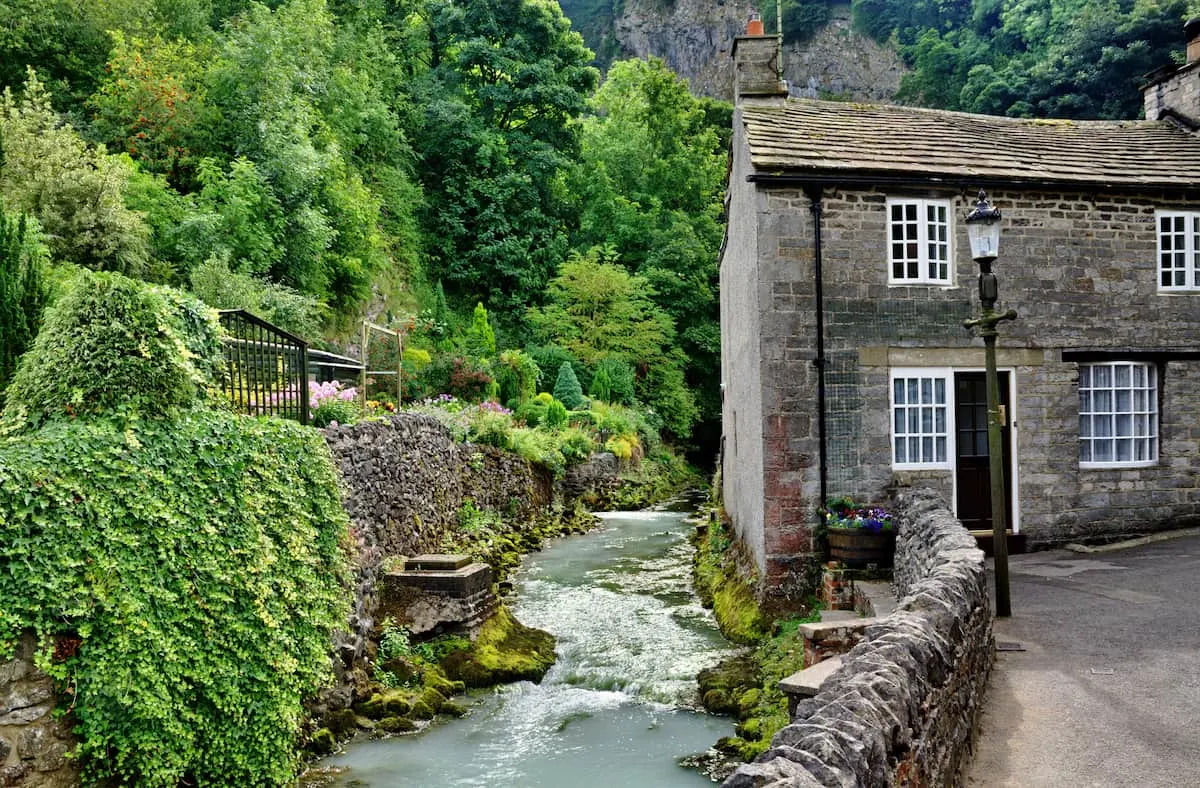
Though it has some serious competition, I think Castleton is the best all-rounder as a place to stay in the Peak District. It’s centrally located, picturesque, full of things to do and surrounded by natural beauty.
Just getting to Castleton is idyllic, as each route into the village weaves through some of the loveliest scenery in the Peak District. Mam Tor is close by, as is the supposedly haunted Winnats Pass – you can start the walk to both from Castleton.
You can wander up to the ancient Peveril Castle or delve into the multitude of caverns for an adventure right on your doorstep. Browse the boutiques of the village, or sit in a cafe or pub. It’s a quaint village with a relaxed atmosphere but has plenty to do.
Castleton has an abundance of natural caves close by, but I think Speedwell Cavern, which involves an underground boat trip, is the best of the bunch.
Blue John, an incredibly rare semi-precious mineral, can only be found in this location in the UK. You can visit the Blue John Cavern or one of the jewellery shops in town for a glimpse of it.
Castleton is infamously home to Peak Cavern, or, as it is more commonly known, the Devil’s Arse.
Named as such for the strange sounds emerging from the cave – which we know now is the result of heavy rain trapping and displacing air, but back then could only be explained by the devil’s flatulence – the Devil’s Arse has been a tourist attraction for centuries.
It was renamed Peak Cavern to avoid offending the visiting Queen Victoria.
Moving through the Devil’s Arse will require some crouching. The natural cave formation was carved higher in its smallest spaces to allow Queen Victoria to walk without stooping her head. At 4’11, or 152cm, that doesn’t leave much wiggle room for the rest of us.
Matlock Bath
Best For: Being Pretty, and a Lot of Fun
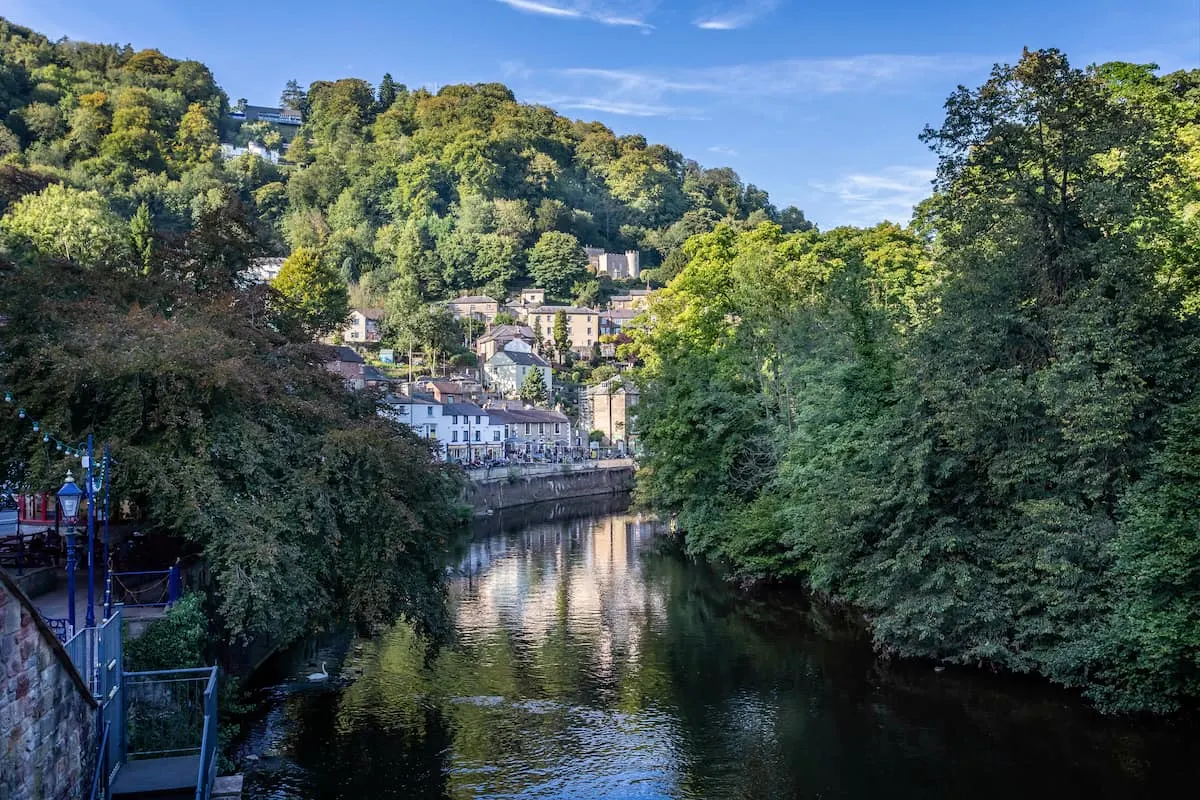
Tumbling down one side of a steep valley, Matlock Bath was built to be pretty. While most towns and villages are the result of workforces settling into communities, Matlock Bath was built with tourism in mind.
After the discovery of natural hot springs in 1698, a bathhouse was built. It became steadily more popular as access improved, but it wasn’t until a young Princess Victoria visited in 1832 that Matlock Bath really established itself.
You can still visit a thermal spa in the village by booking a slot at the New Bath Hotel and Spa. The old Victorian baths are now used as an aquarium.
The main street sits at the base of the valley overlooking the River Derwent, in the shadow of a towering forest. When staying in Matlock Bath, you will hear the hoots of owls in the aforementioned forest overnight. When the crowds have disappeared, you can truly enjoy the village at its picturesque best.
Though the village is miles from the sea, it has the strange feel of a seaside resort. Arcades, fish and chips and a nearby theme park add an eclectic edge to the small village. That’s even ignoring the horde of bikers that tend to make an appearance in Matlock Bath.
The Heights of Abraham, a cable car ride up to caverns and museums, is a popular local attraction.
Because the village is both popular and tiny, it does get busy – but in some ways, that makes it a great base. You can enjoy it in the early morning and evening when the crowds have dispersed, while going out and exploring the rest of the Peak District when it is at its busiest.
Edale
Best For: Epic Hikes and Beautiful Walks
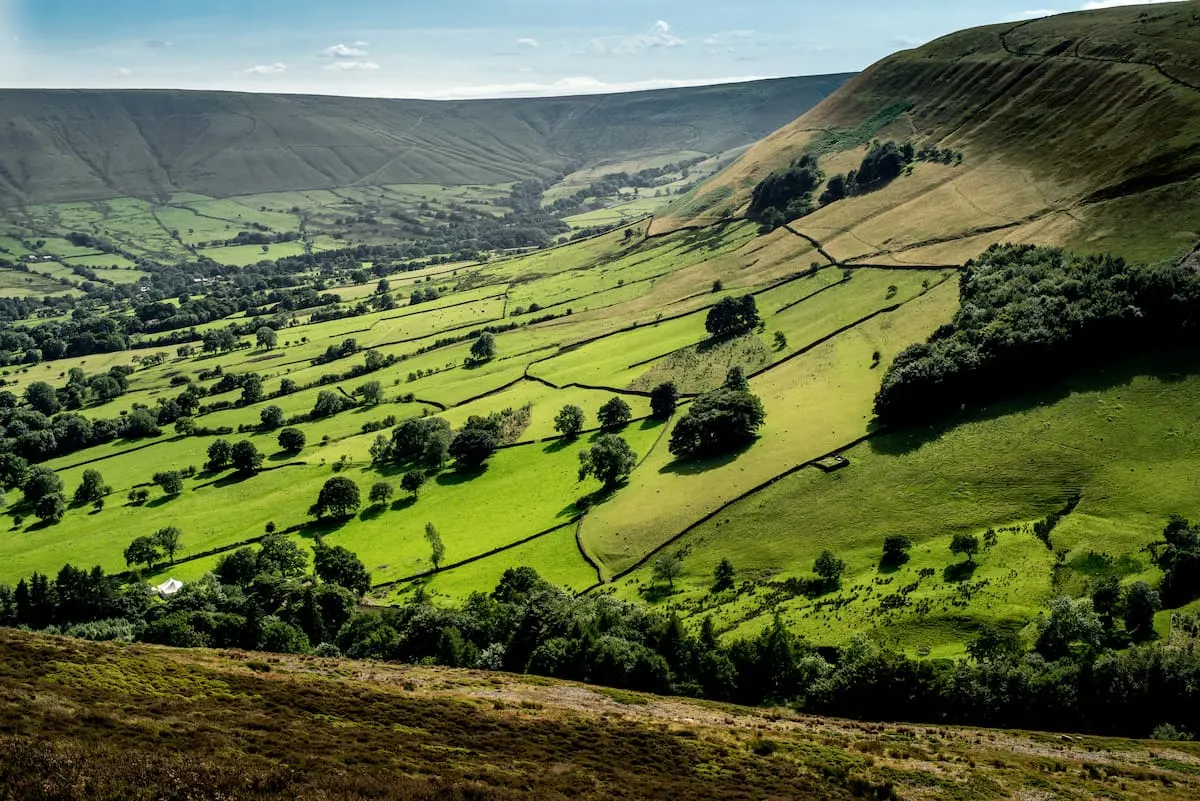
Edale is a sweet little village, but the reason it’s a great place to stay has nothing to do with the village itself.
It’s scenic, charming and easily reachable, but Edale is famous for what’s on the doorstep of the village, not what’s inside it. Some of the Peak District’s most stunning and dramatic scenery can be found just outside the boundaries of the village.
Kinder Scout is the highest point in the Peak District, which, at 636 metres, isn’t all that high. It does provide sweeping views over the landscape, however, and the walk is filled with all the lush greenery and wild beauty you might expect from the area. Wander down to the Mermaid’s Pool for a chance at being granted immortality.
Dalehead, Win Hill, and the Great Ridge of Mam Tor can be found close to Edale. Mam Tor is especially memorable – the jagged ridge is one of the most iconic walks in England. Edale is also famously either the beginning or end of one of Britain’s great hikes, the Pennine Way.
Edale is a fantastic place to stay for people who enjoy long, blustering walks through the countryside. Though it is the scenery that draws people to Edale, the village is undeniably lovely. Pubs, cafes and little stone cottages make up a community that is sure to provide a relaxing getaway.
Baslow
Best For: Falling Charmingly Under-the-Radar
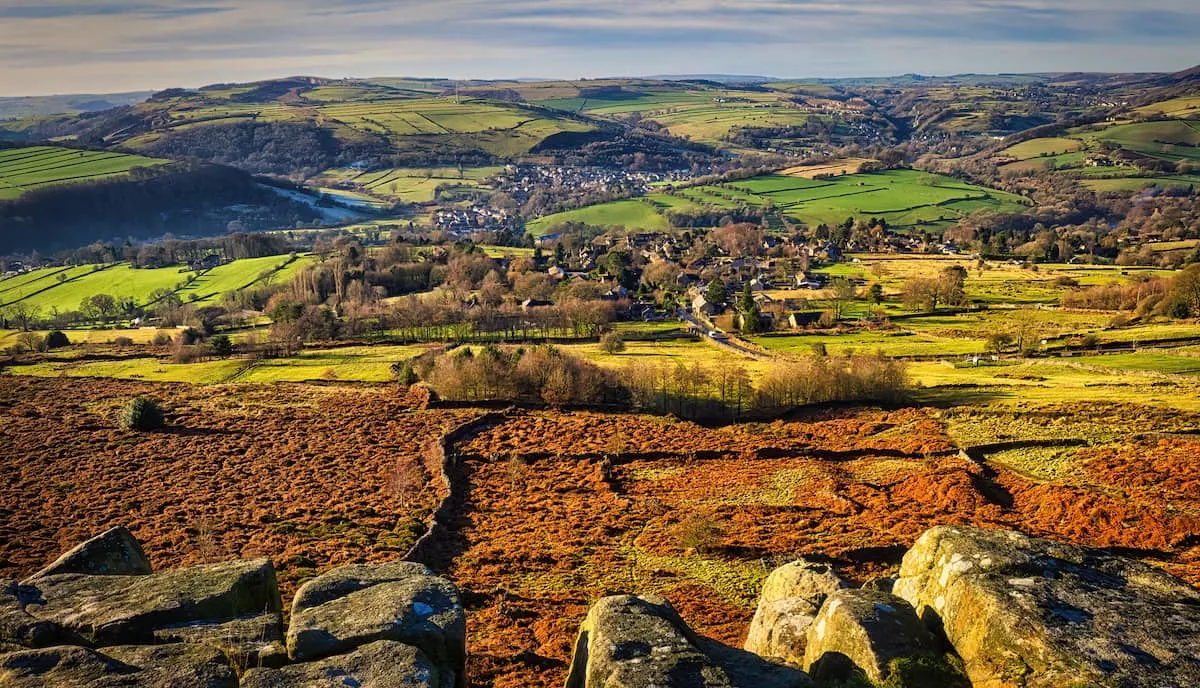
On the doorstep of Derbyshire’s gorgeous Chatsworth House, Baslow is a pretty village that often gets overlooked by people visiting the Peak District.
It’s a delightfully charming example of the postcard-perfect villages typically tucked away in Derbyshire’s countryside. Wander through a scene worthy of the Romantics as you cross the River Derwent, stepping on to a Jacobean stone bridge to enter into the village.
It doesn’t take visitors long to realise this is a community that has changed very little over the centuries; the buildings themselves, made largely from locally sourced sandstone and gritstone, are testament to that.
Baslow is the kind of place you come to slow down and recharge; a reminder to enjoy the simple things in life, whether that’s a ramble through the countryside, or a pint in the village pub. It has the effortlessly laid-back feel you can only really experience in very rural communities.
It takes less than an hour to reach Chatsworth House on foot from Baslow, and would be 4.2 miles in total there and back. The House is home to the Duke and Duchess of Devonshire – it has belonged to the Cavendish family since the 16th Century. Often referred to as Britain’s favourite country house, the opulent decor, Baroque architecture and world-renowned gardens will leave you marvelling for hours.
Baslow is also conveniently located to enjoy many of the Peak District’s most famous sights. Curbar Edge, a craggy rock formation popular with hikers and climbers is to the north, while Bakewell and picturesque Ashford in the Water are a short drive to the southeast.
Eyam
Best For: History Buffs
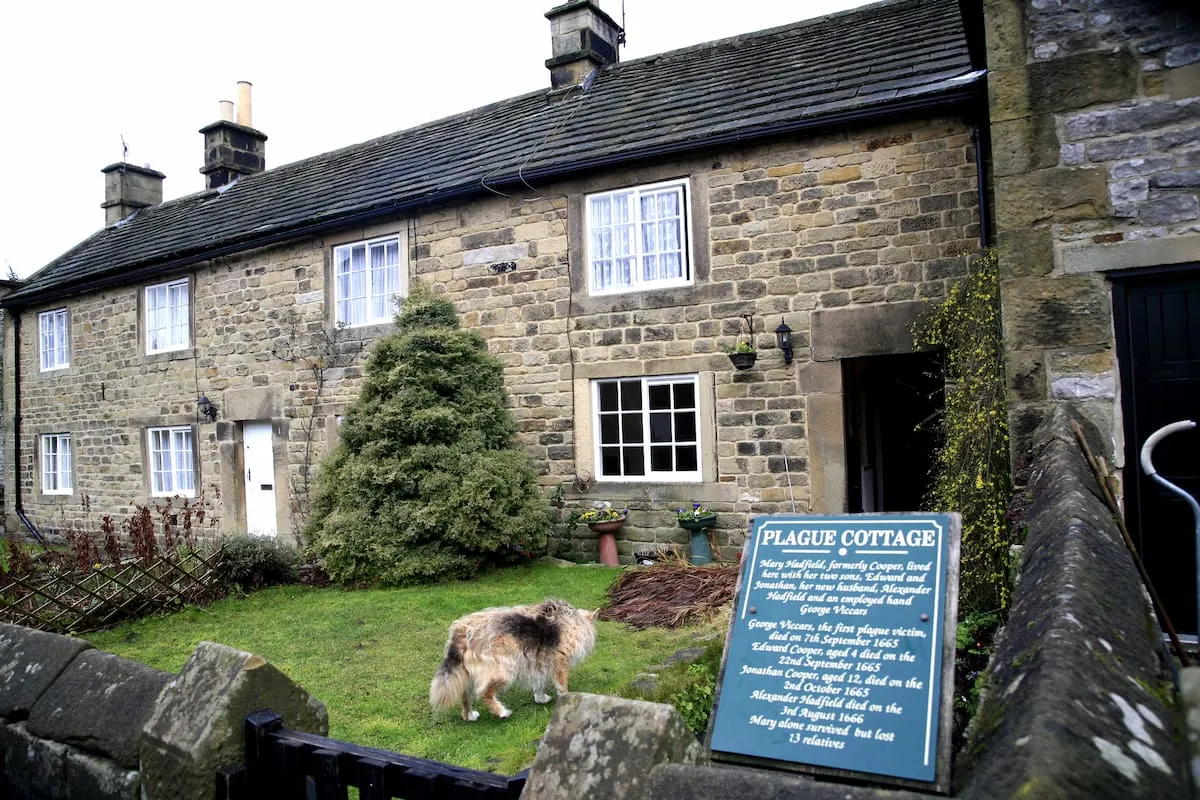
Eyam’s biggest claim to fame is a rather grim one: the village was nearly wiped out by the plague. Fortunately, Eyam hasn’t been blighted by the bubonic plague for centuries – though the story of the village still fascinates people today.
More than a story of disease and death, Eyam’s is one of self-sacrifice. The village is widely-known for its refusal to allow the plague to spread, at great personal cost. In the 17th Century, the people of Eyam isolated themselves from the surrounding communities, enduring a quarantine for 14 months in order to protect others. Though most of the villagers died, they succeeded – saving potentially thousands of lives in the nearby communities.
You can visit the Eyam Museum to find out more about the story of the ‘Plague Village’, as well as learning about Eyam’s history prior to the plague and the recovery afterwards. The boundary stone, where people would leave supplies for the villagers to collect, and a few of the cottages from the time can still be seen by visitors.
Besides learning about its tragic plague connections, Eyam is a fantastic place to stay for its location and picturesque setting. The village is centrally located within the Peak District, close to Bakewell and Chatsworth House, and only a short distance from great walks like the Monsal Trail.
Hathersage
Best For: A Tranquil Escape
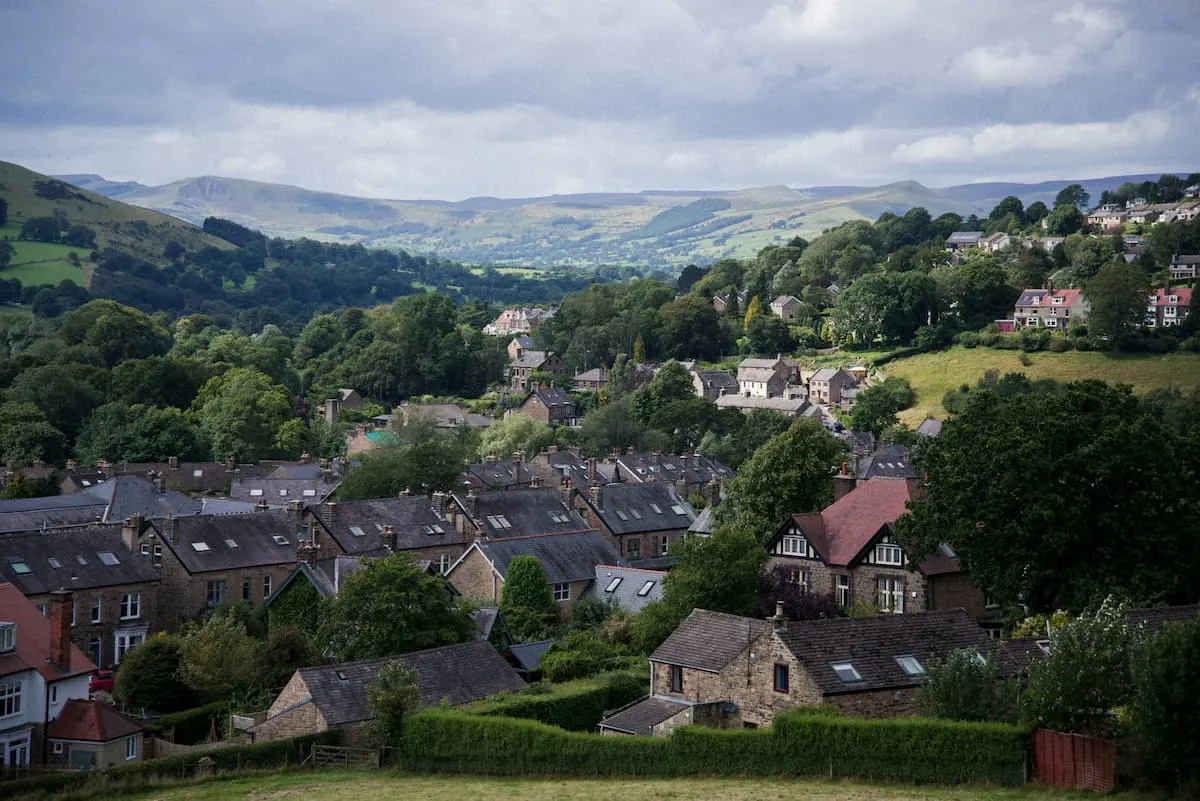
For such an unassuming – if picturesque – village, Hathersage has an unusually large amount of connections to iconic legends and literature.
Most famously, the village served as inspiration for Charlotte Brontë in her greatest work, Jane Eyre. The village itself features heavily in the novel, but the surrounding wild moorlands and rugged peaks are almost characters in themselves: “There are great moors behind and on each hand of me; there are waves of mountains far beyond that deep valley at my feet”.
Charlotte Brontë frequently visited Hathersage with a friend – at the time, the Eyre family was the most prominent family in the area. You can follow a Jane Eyre Trail that takes you to all the main sights of the village.
The graveyard of Hathersage Parish Church is an unmissable part of the village. It has the graves of the Eyre family, including one for a Jane Eyre. But even more famously, it’s the location of the grave of Little John, Robin Hood’s loyal righthand man. According to local legend, Little John’s bow, hat and mail shirt once hung inside the church.
Hathersage, like much of the Peak District, is also a fantastic area for walking. Stanage Edge, the ridge featured prominently with Kiera Knightley in the 2005 film Pride & Prejudice, is typical of the undulating scenery in the area. Another great hike is the short circular route to Hathersage Stepping Stones.
The village, which sits just north of the River Derwent, is also only a short car journey from the impressive Ladybower Reservoir. You can see Derwent Reservoir above it, which hides a sunken village.
If you prefer to be away from some of the busier towns in the Peak District, Hathersage is perfect. It’s pretty, close to everything and has some memorable sights and walks to enjoy.
Where to Stay
All the towns and villages in the Peak District are similar – they tend to be quaint, pretty and closely tied to nature. But they do have slight differences that may improve the quality of your holiday, according to your own preferences.
Whether you would prefer to stay somewhere completely focused on walking like Edale, or a village with a lot of variety like Castleton, you are sure to enjoy your holiday in Britain’s oldest National Park.

Kat
Hi, I'm Kat, an Australian that moved to London in 2013 to start a new adventure. What a roller-coaster that was! I love helping others move to the UK and people explore the world! I’d be honoured if you’d say, “Thanks!” with a £3 coffee on Ko-fi.

